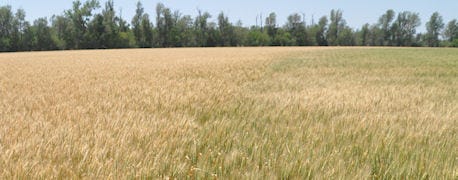
Roger Brining's dryland wheat fields have been devoid of green for more than two weeks now. But on May 16, a walk out into one field revealed that the heads are filling and ripening.
"I have no idea where the energy is coming from. There's not a green leaf in the field," says Brining.
It hasn't rained since April 3 on the Brining farm in Barton County. And there is nothing in the forecast that appears to hold out hope for rain.
Brining said he hadn't shelled out a wheat head to see what the dead-by-all-appearances crop had produced until last Wednesday when he took Kansas Farmer on a tour around the farm.

COLOR GONE: This photo shows the dividing line between a circle of irrigated wheat and a dryland corner. The wheat under irrigation is still green; the dryland portion has been devoid of color for more than two weeks.
"Amazing, there are berries in there, very small berries, but still… given the conditions, that alone is incredible."
Brining said he plans to harvest the fields and will just wait to see what the monitor tells him about yields.
Earlier in the year, the wheat looked so promising that he invested in fungicides to protect it against stripe and leaf rust. Then the rain stopped.
"I knew going in that there was a risk of this happening," he said. "We started off last fall with just no subsoil profile. We got it up and going on occasional showers and through the winter, we were lucky enough to just keep getting a shower when we needed it. But all along, I knew that if the rain stopped, there wasn't anything to fall back on in the subsoil."
Brining said he did some forward contracting of this year's wheat harvest when he got a chance to lock in prices of over $8.50 a bushel.
"I'll have enough irrigated wheat to make the contract," he said, "I have more wheat under irrigation right now that I have ever had. But at the end of last year, I had used up a lot of my water. So I planted wheat under the pivots."
If he has enough water left after wheat harvest, he said he'll plant double-crop soybeans on the irrigated land. If not, he'll plant a forage cover crop mixture and plan on grazing it.
About the Author(s)
You May Also Like






